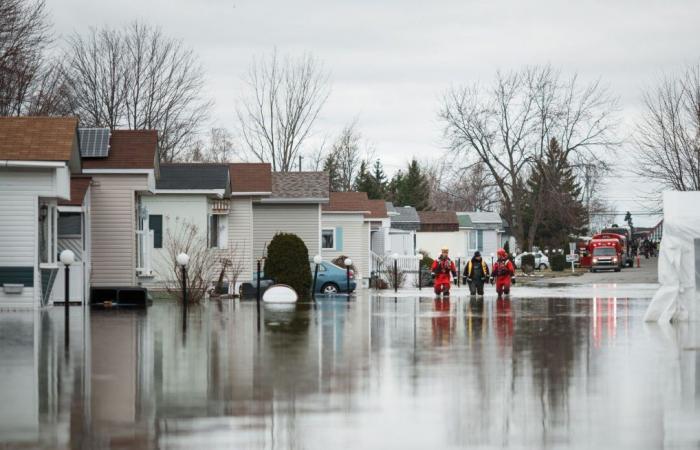Mayors in the Montreal region are having difficulty digesting the new rules imposed by the Quebec government which will double the number of residences located in flood zones. Especially since they feel left to their own devices, obliged to explain to citizens the consequences of a project that they do not control.
“When we became aware of the draft regulation [du gouvernement du Québec]we were stunned,” admits the mayor of Sainte-Marthe-sur-le-Lac, François Robillard. “Overnight, we have 2,000 residences which, with the new regulation, go from a non-flood zone to a flood zone. This is a major financial issue for citizens who are affected directly or indirectly. »
On Monday, the Metropolitan Community of Montreal (CMM) unveiled its new mapping of flood zones, carried out under the modernization of the Quebec regulatory framework last June. The rules established by the Quebec government double the number of residences in the metropolitan region now located in areas at risk of flooding; it is now estimated that 15,508 buildings are located there.
These new rules also introduce a new zone designation system. Previously, flood zones were established based on the recurrence of floods, i.e. 0-20 years (high current) and 20-100 years (low current). They are now designated according to their exposure to flooding — very high, high, moderate or low — with colors ranging from intense red to yellow.
The Sainte-Marthe-sur-le-Lac case
In Sainte-Marthe-sur-le-Lac, the impact is major. The municipality, hard hit by the breach of its dike in 2019, now finds itself in a flood zone while only a few buildings in the city were previously.
Thanks to this dike, the city is colored yellow on the map — which indicates low exposure to flooding — rather than red. But this does not satisfy Mayor Robillard, who judges that his municipality is well protected by the new dike and should not have the same status as a city without such infrastructure. “We are aware that zero risk does not exist, but there are plenty of ways to reduce the risk to the lowest level,” he adds, citing as an example the development of risk reduction plans, which which isn’t even allowed right now.
I’m angry. This is a completely inhumane way to handle the situation. They should have left that to the municipalities.
The elected official recalls that following the floods of 2019, which led to the evacuation of 6,000 residents, Quebec had by decree allowed owners to rebuild their homes without restrictions and had participated in financing the reconstruction of the dike. “This means that today, we have invested 55 million in a flood protection structure which covers the entire front of Lac des Deux-Montagnes and is 26.5 meters above sea level And there, four and a half years later, we find ourselves telling these people that they are now in a flood zone. »
In addition to the expected repercussions on insurance premiums, mortgage loans and the cost of any real estate project (due to the increased requirements), Mayor Robillard fears a drop in the value of residences newly located in flood zones — which would affect not only the owners of these buildings, but also others, who risk having to compensate for the drop in property income caused by these changes.
“Inhumane” management?
“I’m angry,” says the mayor of Vaudreuil-Dorion, Guy Pilon, on the line. “This is a completely inhumane way to handle the situation. They should have left that to the municipalities. And we would have made regulations accordingly. And the government would have withdrawn from there completely. » In his city, the proportion of buildings located in flood zones increased from 1.3% to 9.7%, for a total of 2,085 residences (including 35 in very high exposure zones) and a total land value of nearly of 1.2 billion dollars.
According to Mayor Pilon, Quebec sought to resolve the problem without really caring about the economic and psychological consequences of its decision on the people affected.
Citizens’ apprehensions are real, believes the mayor of Pointe-Calumet, Sonia Fontaine. “The fears, obviously, are especially in the resale market. There is a significant financial loss that would be made if the entire territory [était désigné] floodable. Loss of [valeur de] resale, insurability of homes and mortgage financing of properties in flood zones. It is becoming very difficult, contrary to what the government is currently suggesting. »
The mayors are also angry with the provincial government for leaving it to municipalities to respond to people’s concerns, even if the issue falls under Quebec’s jurisdiction. Because they are the ones on the ground and who, during municipal councils, must answer citizens’ questions, they say.
Quebec organized three webinars this summer, but the government’s efforts to inform citizens of the new draft regulation were limited to this initiative, maintains the mayor of Sainte-Marthe-sur-le-Lac. “A consultation in the middle of summer doesn’t help. […] We are stuck answering citizens’ questions, even though we don’t have all the information,” laments François Robillard. “Many citizens have not yet realized the extent that this regulation will have on their daily lives and their territory. »
Several cities have set up door-to-door operations to keep their citizens informed of the consequences of these changes. But even for municipal representatives, the file remains complex.
The mayor of Vaudreuil-Dorion also deplores the absence of the Quebec government on the ground. “I challenge the Minister of the Environment, the one who decreed this, to come to a consultation evening here in the city, in the region. He’ll need to have a damn big room. Then he’ll see what it is,” says Guy Pilon.
In Laval, the number of residences in flood zones will increase from 1,100 to nearly 2,500. The city’s mayor, Stéphane Boyer, and the CMM are also asking Quebec to meet citizens to explain the new regulations to them. “We think that it is the government of Quebec that should do this work, but we do not want to leave citizens in the unknown,” says the elected official.






